Japanese confectionery, known as "Wagashi," embodies a delicate artistry that has been refined over centuries. These sweets, crafted with meticulous attention to detail, reflect Japan's cultural heritage and seasonal traditions. From the iconic mochi and elegant yokan to the intricate wagashi served during tea ceremonies, each confection showcases a harmonious blend of flavors, textures, and aesthetics. Utilizing premium ingredients such as sweet azuki beans, matcha green tea, and delicate sakura blossoms, Japanese confectionery offers a sensory experience that delights the palate and nourishes the soul. Rooted in craftsmanship and respect for nature, these sweets are a cherished part of Japan's culinary legacy.
Dango
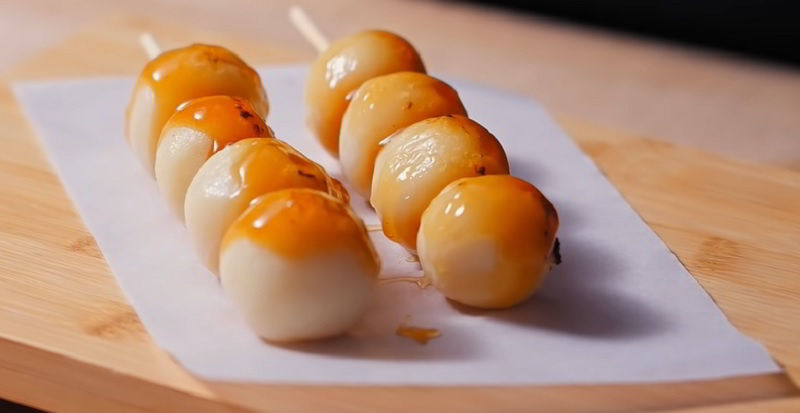
Dango is a beloved Japanese dessert that showcases small, round dumplings crafted from mochiko, a type of glutinous rice flour. This delightful treat is particularly enjoyed during festive occasions. Typically, dango is skillfully threaded onto bamboo skewers, with each serving featuring a cluster of three or four dumplings. Dango's versatility is evident in its various forms, each boasting its own distinct taste and presentation. For instance, mitarashi dango boasts a luscious sweet soy glaze, while anko dango is filled with delectable sweet red bean paste. Yomogi dango brings a unique twist with its infusion of mugwort, resulting in a vibrant green hue. Additionally, kushi dango takes dango to new heights by offering an array of toppings such as kinako (roasted soybean flour) or sesame seeds. The texture of dango is soft and chewy, with a gentle stickiness that adds to its appeal. Its delicate sweetness does not overpower the palate, making it an ideal indulgence for those with a penchant for sweets. The combination of the tender dumplings and the sweet glaze or filling harmoniously melds together to create a delightful balance of flavors.
Taiyaki
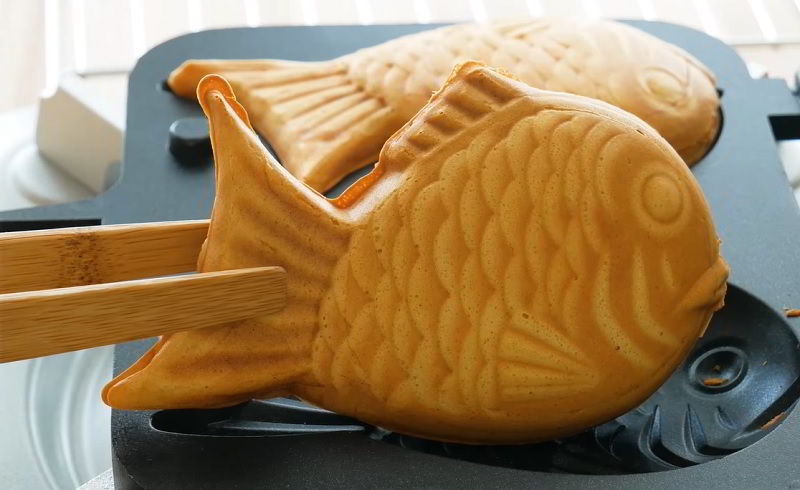
Taiyaki is a sweet treat made by pouring a batter, usually made of flour, sugar, and eggs, into fish-shaped molds and filling them with delicious fillings. The name "taiyaki" translates to "baked sea bream," which refers to its fish-shaped appearance resembling a sea bream. Traditionally, taiyaki was filled with a sweet red bean paste called "anko," which is made from azuki beans. However, nowadays, various flavors have emerged, including custard, chocolate, cheese, matcha, and even savory options like cheese and sausage. The batter is then cooked until golden brown, giving the taiyaki a crispy exterior while maintaining a soft and fluffy interior. The result is a delightful combination of textures and flavors that are both comforting and indulgent. Taiyaki is often enjoyed as a street food, where vendors sell them fresh and hot off the griddle.
Wagashi
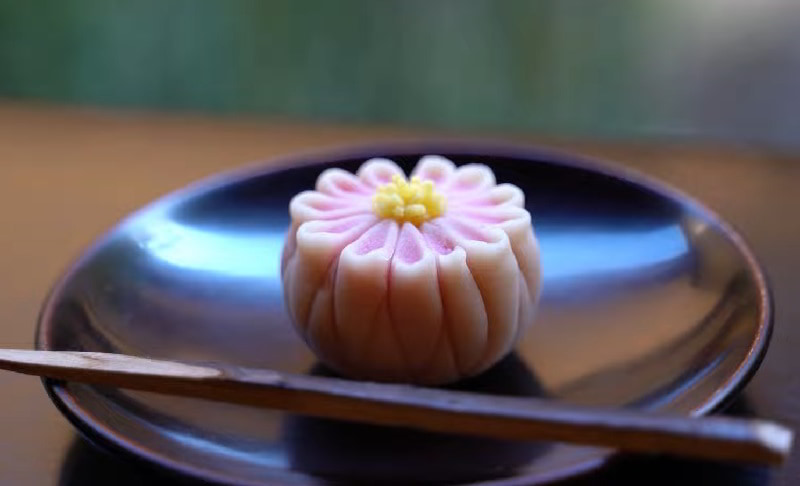
Wagashi, a traditional Japanese sweet dish, offers a diverse range of desserts and sweets. Renowned for their exquisite presentation, vibrant colors, and delicate flavors, these treats captivate the senses. Wagashi embraces the use of natural and seasonal ingredients, serving as a reflection of Japan's ever-changing seasons. Among the popular varieties, mochi stands out—a chewy rice cake crafted from glutinous rice flour and filled with delectable sweet bean paste, such as azuki or white bean. Similarly, dorayaki, featuring two fluffy pancake-like layers, encases a delightful sweet bean filling. Wagashi also encompasses beautiful fruit jellies, agar-based desserts, and yokan, a thick, sweet jelly made from red bean paste. These sweets often take on intricate designs, showcasing the skill and artistry of Japanese confectioners, with shapes ranging from flowers to animals. Appreciated not only for their taste but also for their aesthetic appeal, wagashi is commonly enjoyed alongside green tea during traditional tea ceremonies or as a delightful dessert to conclude a meal.
Daifuku
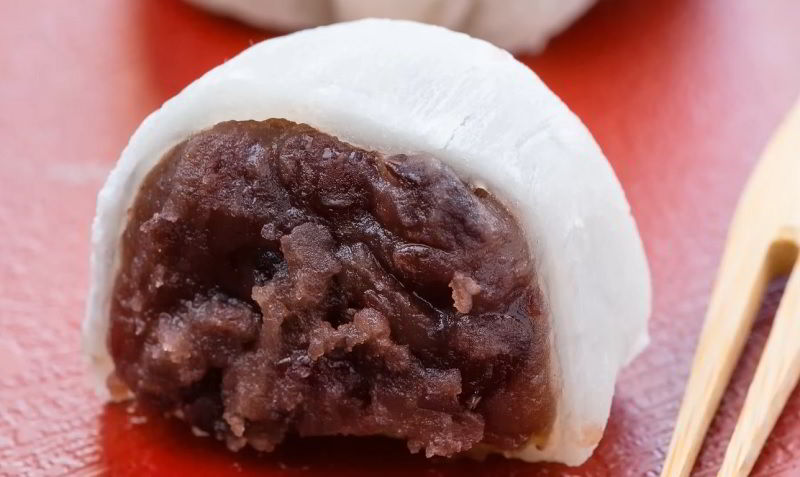
Daifuku, a beloved traditional Japanese dessert, is renowned for its soft and chewy texture. This delightful treat consists of a small round mochi, a glutinous rice cake, filled with a sweet and luscious red bean paste known as anko. The mochi is skillfully crafted by pounding glutinous rice into a pliable dough, which is then shaped into bite-sized balls. The anko filling is traditionally created by boiling and sweetening azuki beans, resulting in a velvety smooth paste. However, daifuku also comes in various other flavors such as matcha or fruit fillings. Its appeal extends beyond taste, as this dessert boasts vibrant colors and a silky texture. It is often served as a special indulgence during Japanese festivals or as a delightful conclusion to tea ceremonies. Regardless of age, the combination of the tender and slightly chewy mochi with the sweet and flavorful anko filling offers an enchanting taste experience that is universally adored.
Pocky
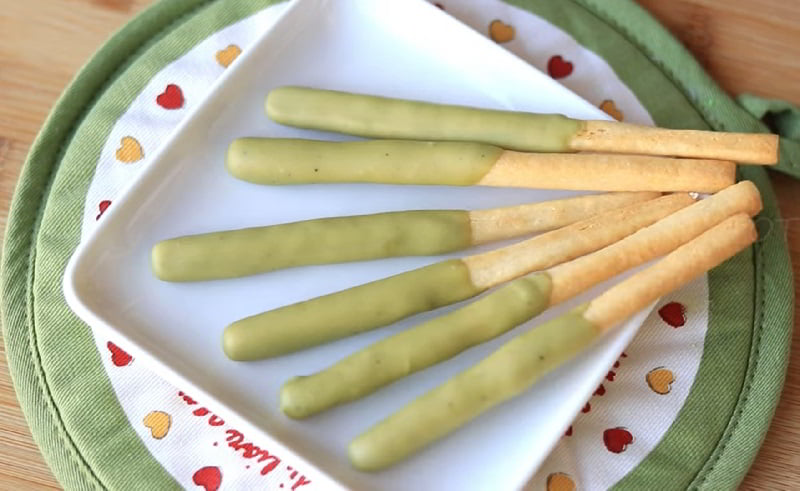
Pocky, created by Yoshiaki Koma and manufactured by Ezaki Glico, is a delightful Japanese treat. It consists of crispy biscuit sticks covered in a range of delicious flavors. The name "Pocky" originates from the Japanese word "pokkiri," which imitates the sound made when the snack is snapped. The available coatings include an assortment of delightful flavors like chocolate, almond, strawberry, banana, coconut, and many others.
Dorayaki
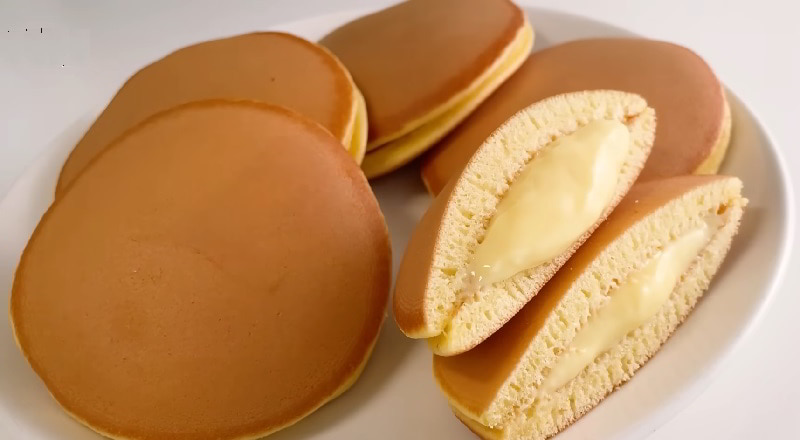
Dorayaki is a classic Japanese dessert comprising two small pancake-like patties enclosing a delectable sweet filling in the middle. These pancakes are a beautiful golden brown color and are prepared using a mixture of flour, sugar, eggs, and baking powder, resulting in a light and slightly chewy texture. The most popular filling for Dorayaki is an exquisite sweet red bean paste known as "anko," which is made by boiling and mashing azuki beans and blending them with sugar. Anko boasts a luscious and creamy consistency that perfectly complements the tender pancakes. However, there are also various other options available, such as custard, chocolate, matcha, and even fruit fillings. The softness of the pancakes combined with the sweetness of the filling provides a delightful and satisfying experience that is truly harmonious.
Konpeitō
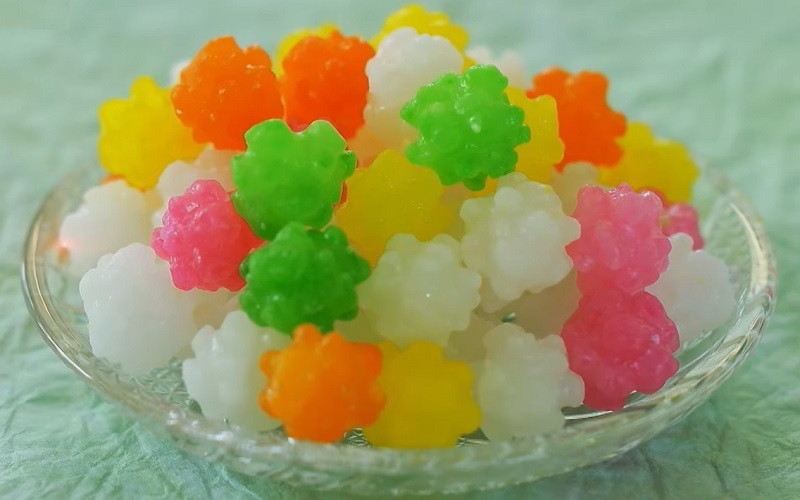
Konpeitō is a traditional Japanese confectionery dish that is loved for its vibrant colors and delicate flavor. These tiny, sugar-coated candies are made by slowly and meticulously crystallizing sugar syrup. The process involves repeatedly coating small sugar cores with layers of syrup, resulting in a hard, glass-like shell. The unique texture and delicate sweetness of konpeitō have made it a beloved snack among people of all ages. The process of making konpeitō is an art that demands great skill. It begins with heating sugar syrup to a high temperature, which is then poured onto a tray to cool and solidify. The hardened sugar is then broken into tiny fragments and placed in a rotating drum. As the drum spins, layers of syrup are gradually added, creating a smooth and glossy surface.
Imagawayaki
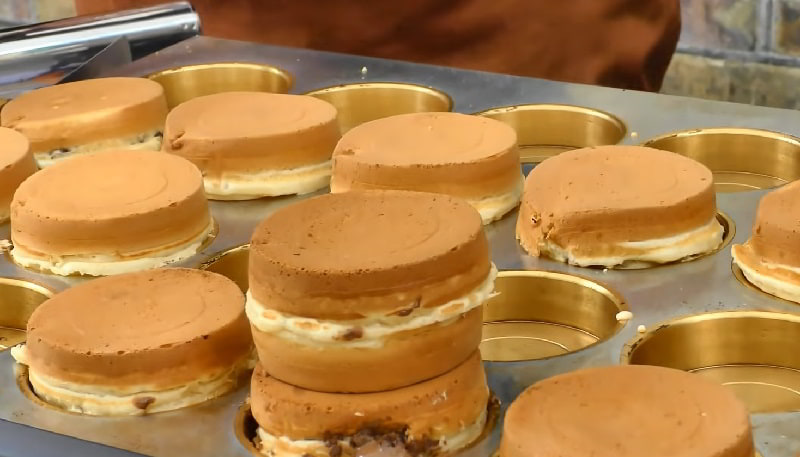
Imagawayaki is a classic dessert consisting of two fluffy pancakes sandwiching a delectable sweet filling. The pancakes are created from a batter that combines flour, sugar, eggs, and baking powder, resulting in a soft and slightly crispy texture. There are various options for the filling, including red bean paste (anko), custard, chocolate, and even savory choices like cheese or meat. The most traditional and widely enjoyed filling is anko, which has a sweet and slightly earthy flavor that complements the pancakes perfectly. To achieve its unique shape, Imagawayaki is cooked in a special iron griddle with half-circle molds. The griddle is heated, and the batter is poured into the molds, followed by the chosen filling. Once cooked, the pancakes turn golden brown and emit an enticing aroma.
Manjū
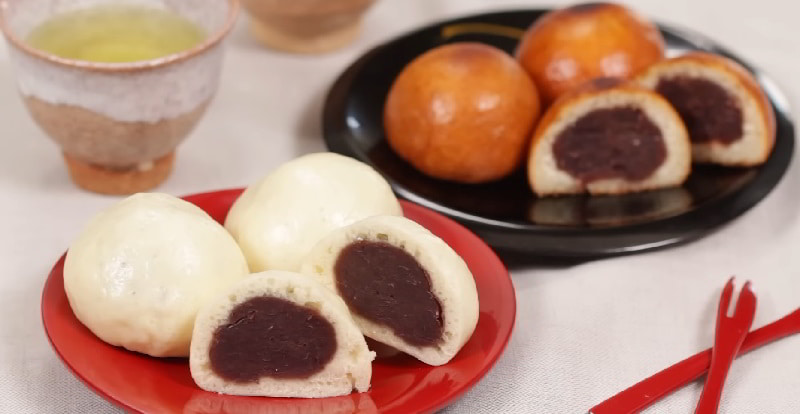
Manjū is a beloved traditional Japanese dessert that is known for its delicate texture and delightful fillings. This sweet treat is created by steaming a soft, slightly chewy dough made from a combination of flour, rice powder, kudzu, and buckwheat. The dough is then lovingly filled with a variety of sweet fillings, such as red bean paste (anko), matcha green tea, chestnut, or even fruit preserves. While the shape of manjū can differ, it is often found in a round or oval shape with an intricate pleated design on top. The outer layer of the dough is typically soft and slightly sticky, offering a unique texture that is enjoyable both to touch and to eat. The flavors of manjū range from subtly sweet to rich and indulgent, depending on the chosen filling. The red bean paste filling stands as the most popular and traditional option, imparting a sweet and earthy flavor to the manjū.
Warabimochi
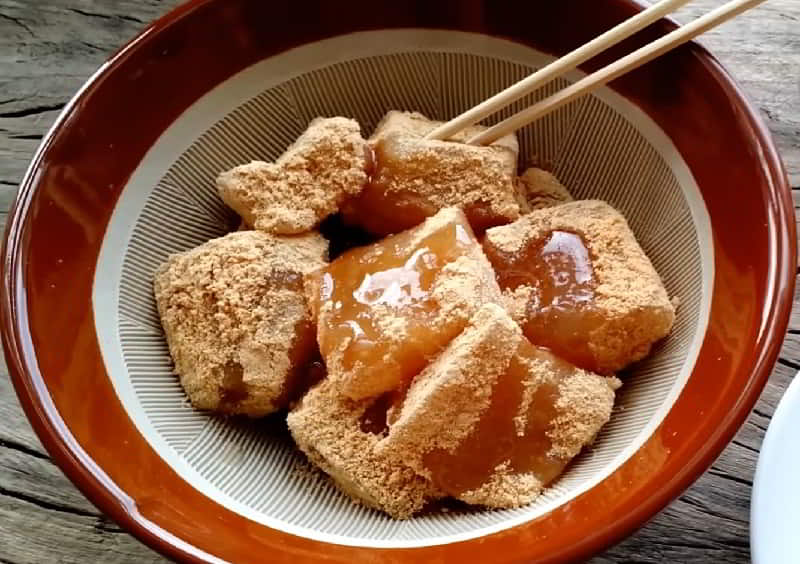
Warabimochi is a one-of-a-kind dessert crafted from bracken starch, resulting in a delightfully chewy and jelly-like consistency. This treat is typically enjoyed with a generous dusting of kinako, a roasted soybean flour, and a drizzle of kuromitsu, a luscious black sugar syrup. The combination of flavors and textures in this dish is perfectly balanced. The bracken starch provides a refreshing and slightly earthy flavor, while the kinako adds a nutty and toasty taste. The kuromitsu brings a deep and caramel-like sweetness that elevates the overall experience. Not only is Warabimochi delicious, but it also captivates the eyes with its soft, translucent jelly-like cubes, coated in golden kinako and glistening kuromitsu. It's an irresistible presentation.
Karumeyaki
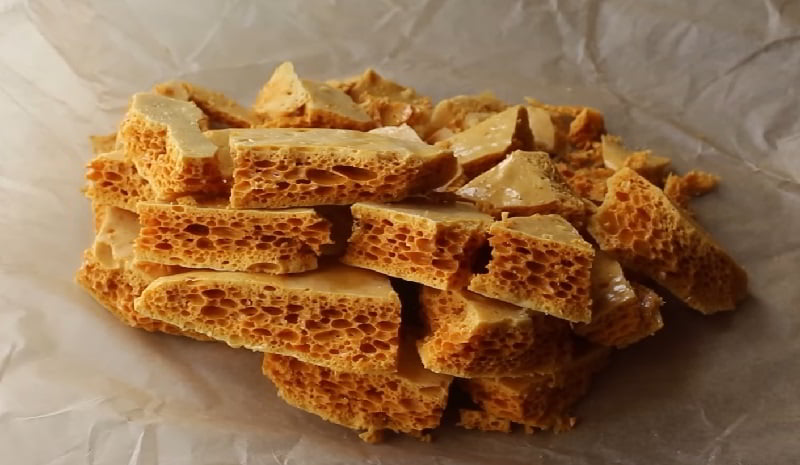
Karumeyaki, also known as honeycomb toffee in Japanese, is crafted by heating sugar and incorporating baking soda. This process triggers a foaming reaction, causing the mixture to expand and resulting in a delightful light and airy texture, reminiscent of honeycomb. Afterward, the toffee is shaped into small, easily consumable pieces, ensuring a satisfying crunch with every bite. What distinguishes honeycomb toffee is its exceptional balance of sweet and savory flavors. The caramelized sugar delivers a luxurious sweetness, while the addition of baking soda imparts a subtle touch of saltiness. This delightful combination creates a truly addictive and harmonious taste experience.
Yōkan
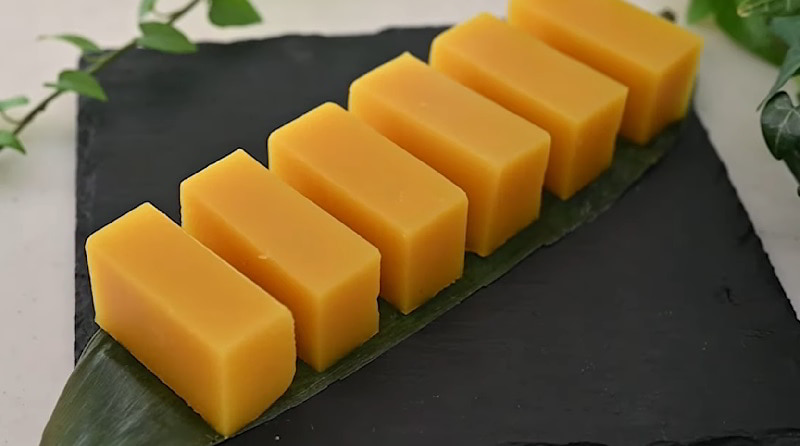
Yōkan, a traditional Japanese sweet dish, has been enjoyed for centuries. This jelly-like dessert is made from red bean paste, agar-agar (a seaweed-derived gelatin), and sugar. With its various shapes, sizes, and flavors, yōkan offers a delightful range of options for dessert lovers. Its texture is firm yet smooth, allowing for easy slicing into bite-sized pieces. The most common flavor is azuki yōkan, made from sweetened red bean paste. However, there are also other flavors available, like matcha (green tea) yōkan, chestnut yōkan, and even fruit-infused yōkan. Yōkan is often served chilled during the hot summer months, providing a refreshing treat to beat the heat.
Senbei

Senbei, a time-honored Japanese confectionery, has delighted people for centuries. Crafted from rice, it offers a delightful array of shapes and flavors, making it a versatile and beloved treat. The rice is meticulously cooked before being transformed into thin, crispy crackers. These crackers can be baked or grilled, resulting in a distinctive and satisfying texture. Senbei tantalizes taste buds with a wide variety of flavors, ranging from savory to sweet. Popular savory options include soy sauce, wasabi, and seaweed, while sweet alternatives may feature sugar or honey. To enhance the flavor experience, the crackers are often seasoned with sesame seeds, nori (dried seaweed), or chili powder, elevating them to new gustatory heights.
Arare
-1706083919.jpg)
Arare is a traditional Japanese confectionery dish that is known for its delightful texture and unique flavors. These bite-sized treats are made from glutinous rice that has been shaped into small balls and then toasted or deep-fried. The rice balls are then coated with a variety of seasonings, such as soy sauce, sugar, or savory spices, to create a wide range of flavors. One of the standout features of arare is its crunchy exterior, which is achieved through the toasting or frying process. This gives the confectionery a satisfying texture that is both crispy and chewy. The flavors of arare can vary greatly depending on the seasonings used, ranging from sweet and salty to savory and spicy. Arare is often enjoyed as a snack or accompaniment to tea in Japan. It is also a popular treat during festivals and special occasions.
Kakigōri
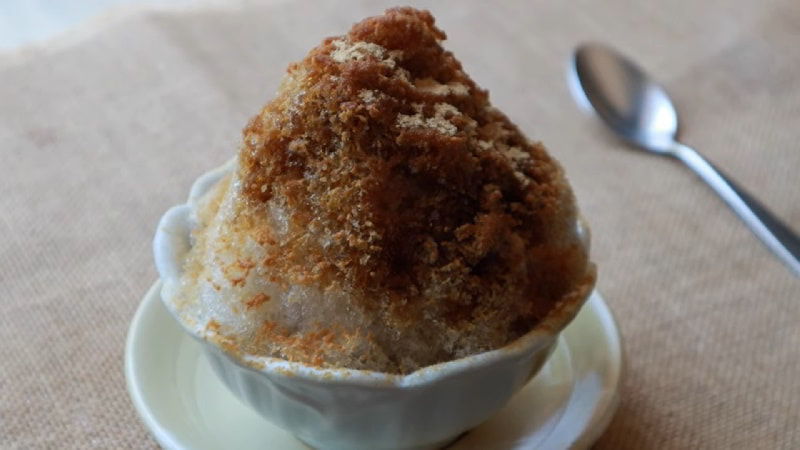
Kakigōri is a delightful treat crafted from finely shaved ice and infused with delicious syrups. This refreshing dish boasts a delicate and fluffy texture that simply melts in your mouth. To enhance the experience, Kakigōri is commonly garnished with a plethora of toppings and sauces, including sweetened condensed milk, fresh fruit, and traditional Japanese ingredients like red bean paste or green tea syrup. These additions impart an explosion of flavors and textures, taking this already delightful dish to new heights.
Monaka
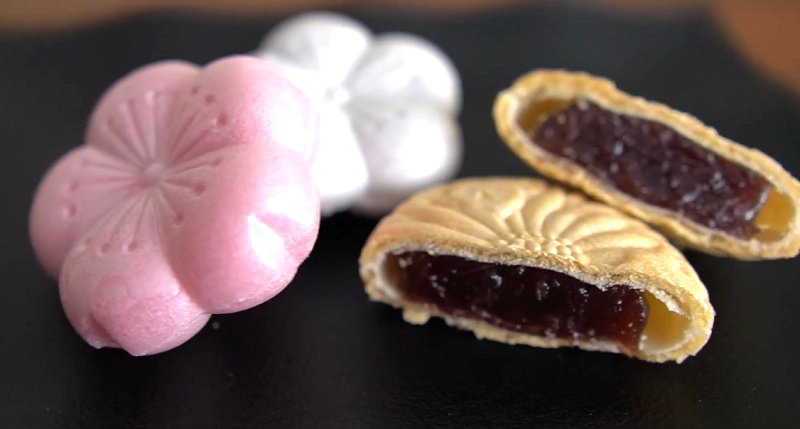
Monaka, a traditional Japanese dessert, is made by sandwiching a sweet filling between two crispy wafers. These wafers, crafted from glutinous rice flour, are thin and light, lending a delicate crispiness that enhances the overall texture of the dish. The filling options are diverse, including popular choices like red bean paste (anko), matcha-flavored cream, chestnut paste, and fruit preserves. Notably, monaka's versatility sets it apart. It can be relished as a standalone treat or utilized in various desserts like ice cream sandwiches or parfaits.
Sakuramochi
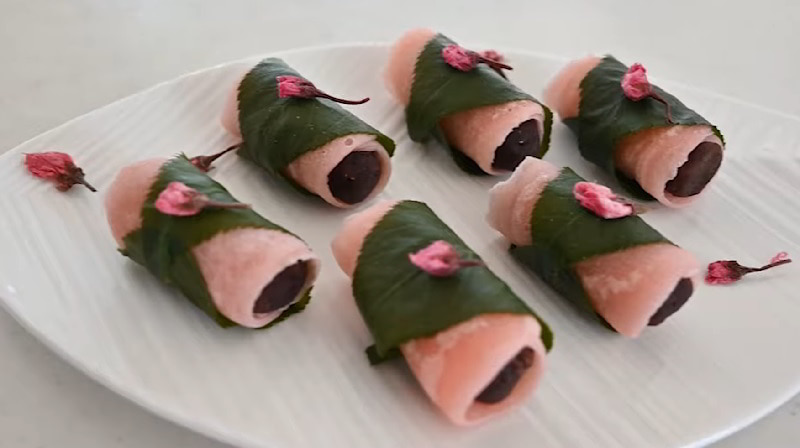
Sakuramochi is a classic treat from Japan made with mochi, a sticky rice cake, and filled with sweet anko, a red bean paste. What sets sakuramochi apart is its lovely pink hue, reminiscent of cherry blossoms, making it a popular choice in the springtime. The mochi is wrapped in a pickled cherry leaf, adding a subtle tangy taste to the sweet filling. The combination of the chewy mochi and creamy anko creates a delightful contrast in textures. The cherry leaf also adds a touch of sophistication to the dessert, making it a go-to option for special occasions and festivities. Sakuramochi beautifully embodies the elegance and delicacy of Japanese sweets, capturing the essence of cherry blossoms both in flavor and presentation.
Yatsuhashi
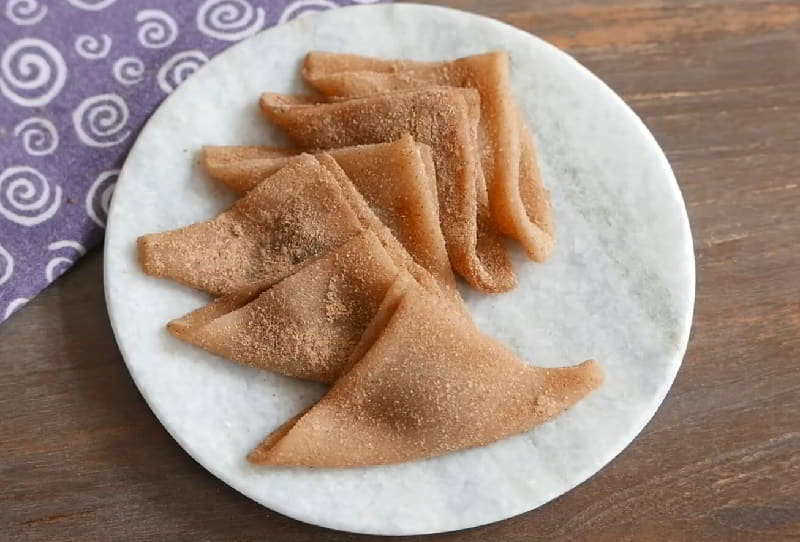
Yatsuhashi is a popular Japanese souvenir snack that hails from Kyoto. This confection is made using a combination of glutinous rice flour, sugar, and cinnamon. Once baked, it takes on a texture similar to senbei, a traditional Japanese rice cracker. One of the distinctive features of yatsuhashi is its shape, which resembles either a Japanese harp or koto, or a lengthwise-cut bamboo stalk.
Anmitsu
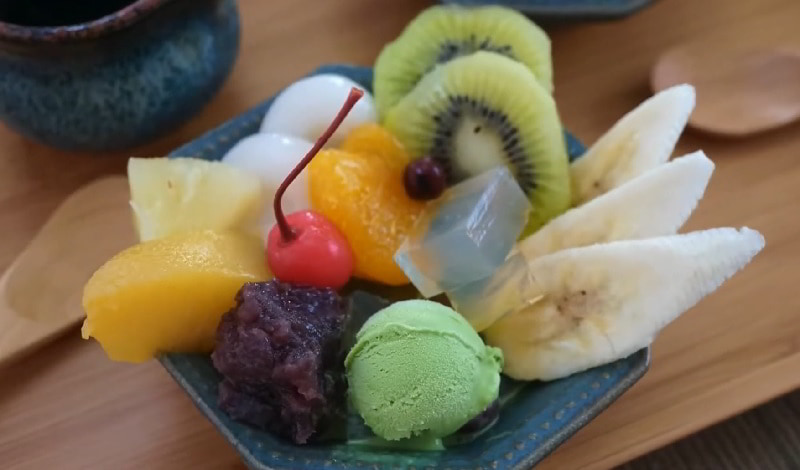
Anmitsu typically includes cubes of agar jelly, sweet azuki bean paste, assorted fruits like melon, peach, and strawberry, and a scoop of vanilla ice cream, all served together in a bowl. The agar jelly, derived from red algae, has a firm yet delicate texture that adds a refreshing element to the dessert. The velvety azuki bean paste adds a sweet and earthy flavor that perfectly complements the fruits' natural sweetness. Chosen for their vibrant colors and juicy nature, the fruits contribute a fresh and succulent component to the dish. Anmitsu is commonly accompanied by a sweet syrup made from sugar and water, which is drizzled over the ingredients, enhancing the overall sweetness and harmonizing the flavors. To further enhance the taste and visual appeal, the dish is often garnished with a sprinkle of roasted soybean flour or a cherry on top.
Shiroi Koibito
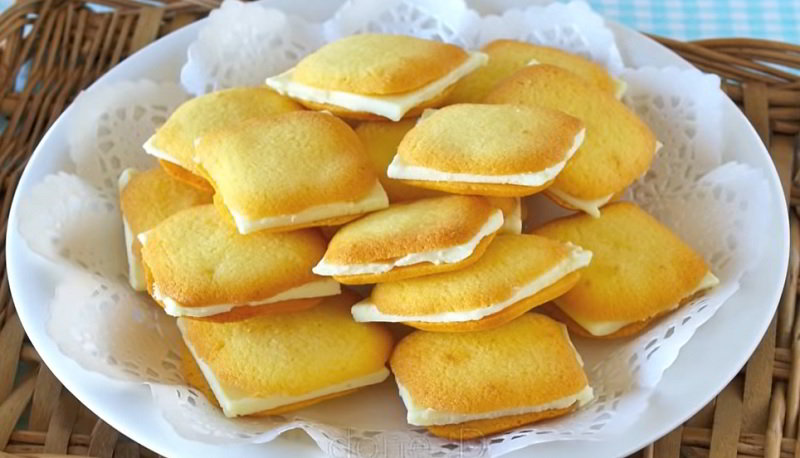
Shiroi Koibito, also known as "White Lover" in English, is a well-loved Japanese delicacy. This delectable treat consists of two delicate, buttery cookies that are gently fused together with a luscious layer of smooth, creamy white chocolate. The cookies themselves are airy and crisp, creating a delightful contrast to the indulgent sweetness of the white chocolate filling. Crafted from top-notch ingredients, the white chocolate boasts a velvety texture and a subtle hint of vanilla. Adding to its allure, the Shiroi Koibito dish comes in exquisite packaging. Each cookie is individually wrapped in a distinctive blue and white box, adorned with a charming illustration depicting a couple dressed in traditional Japanese attire.
Keiran Somen
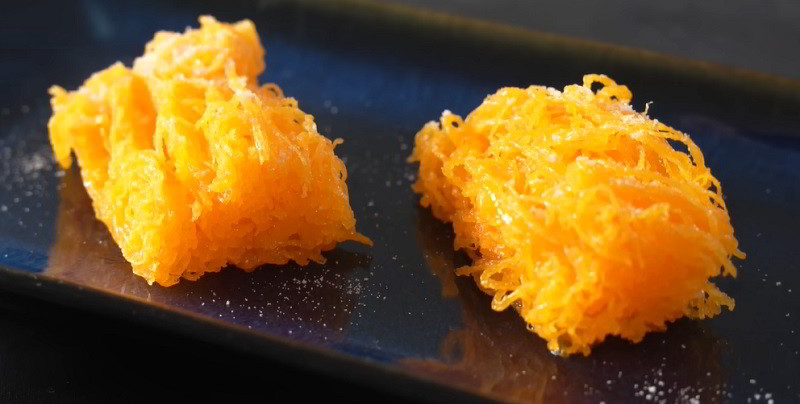
Keiran Somen draws inspiration from the Portuguese dessert known as 'Fios de ovos'. This delightful treat consists of egg yolks cooked in a sugar syrup, resulting in a sweet and indulgent dessert. To make Keiran Somen, whisked egg yolks are strained through a fine sieve, creating fine threads. These threads are then cooked in a sugar syrup until they become translucent and glossy. The end result is a dessert that is soft, sweet, and has a delicate texture. Keiran Somen is commonly used as a topping or filling for various Japanese desserts, such as dorayaki (sweet pancakes) or anmitsu (jelly and fruit dessert). It adds an elegant and sweet touch to these already delicious treats.
Botan Rice Candy

Bontan Rice Candy belongs to the bontan ame category of Japanese candy. These candies are soft and chewy with a refreshing citrus flavor. They are usually covered in a thin layer of rice paper or Oblaat, which is transparent and has a plastic-like texture when dry. However, it is completely edible and dissolves in the mouth. The candy typically contains ingredients like glucose syrup (made from corn starch and water), sugar, sweet rice, water, and lemon or orange flavoring.
Tokoroten
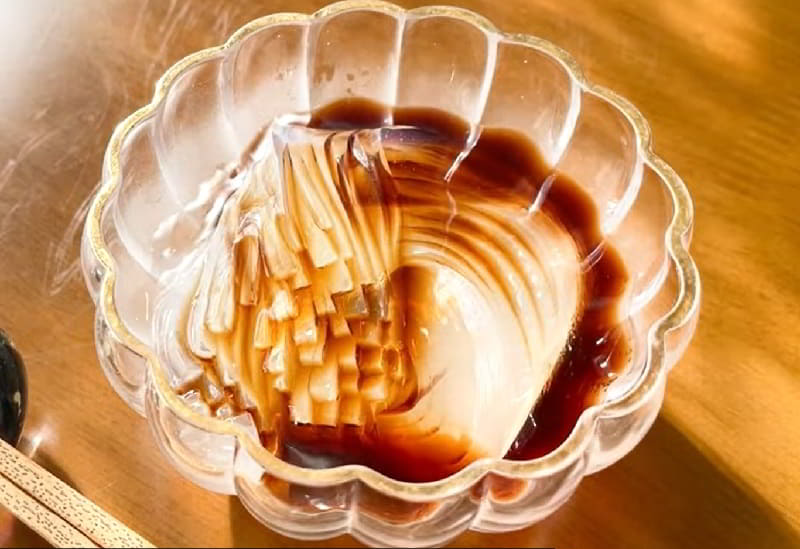
Tokoroten is a traditional Japanese confectionery that originated in the Edo period. It is made from tengusa, a type of seaweed, which is cooked and then formed into a gel-like substance. The gel is then cut into thin, noodle-like strands, giving it a unique and delicate texture. Generally served cold, tokoroten possesses a distinctive texture that combines chewiness with a jelly-like consistency. The production process involves boiling tengusa, a specific type of seaweed, and subsequently solidifying it into a gelatinous form. The resulting jelly is then artfully sliced into slender strips or cubes, accompanied by a light dipping sauce based on soy sauce. Occasionally, grated ginger or sesame seeds are sprinkled as additional toppings to intensify the flavor. What sets tokoroten apart is its reputation as a low-calorie and high-fiber snack, ensuring a guilt-free indulgence.
Botamochi
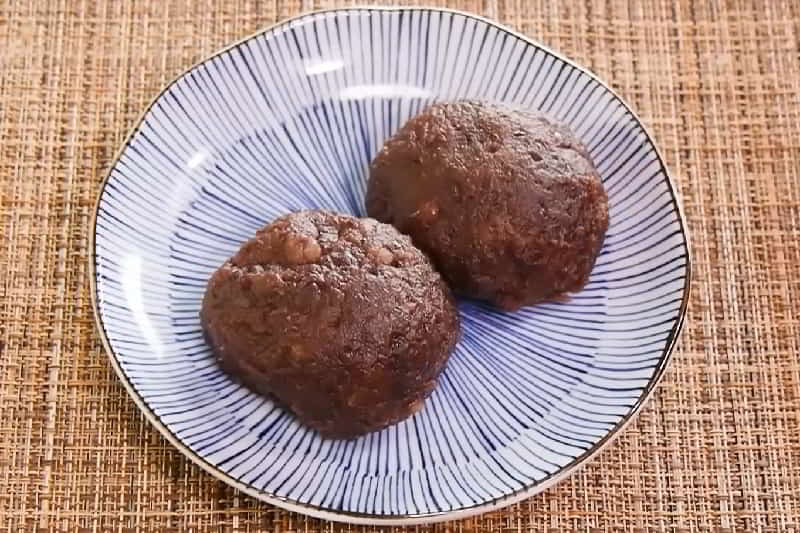
Botamochi, a traditional Japanese dessert, is a delightful combination of a round mochi (glutinous rice cake) and sweet azuki bean paste. The mochi's soft and chewy texture is achieved by pounding the rice. The name "botamochi" is inspired by the peony flower, as the mochi's shape resembles its petals. To enhance its visual charm, a cherry blossom leaf is often used as a garnish. The sweetness of botamochi is balanced, allowing the natural flavors of the azuki bean paste to take center stage.
Karintō
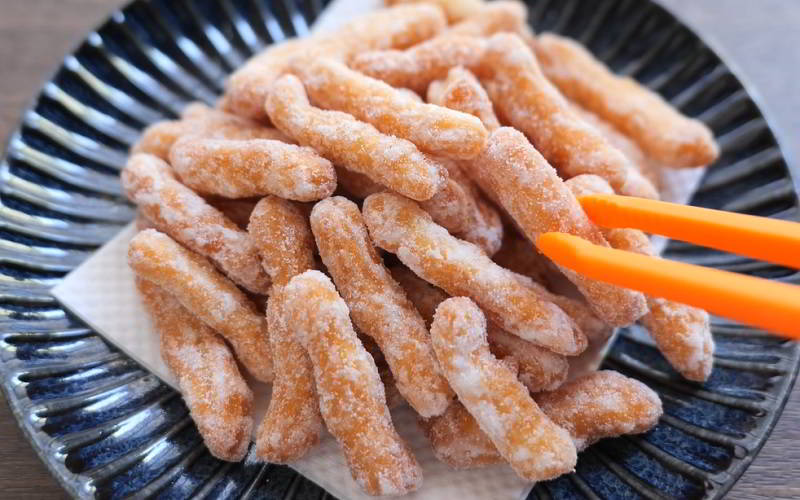
Karintō, a beloved traditional Japanese sweet snack, is cherished for its delightful sweetness and crispy texture. This delectable treat is created by deep-frying a combination of flour, yeast, and brown sugar. With its dark brown, textured surface, Karintō takes on the shape of a small pillow or a short cylinder.
Kibi Dango
-1709202204.jpg)
Kibi Dango, a traditional Japanese sweet treat originating from Okayama Prefecture, is a delightful delicacy. These small dumplings are crafted from kibi, a special millet grain, which imparts them with a unique texture and flavor. To create kibi dango, the millet is cooked and ground into a fine powder. This powder is then combined with glutinous rice flour and water to produce a dough. The dough is shaped into small balls and steamed until they achieve a soft and chewy consistency. Kibi dango can be savored on its own or paired with various toppings, such as kinako (roasted soybean flour), black sesame powder, or sweet azuki bean paste.
Kuzumochi
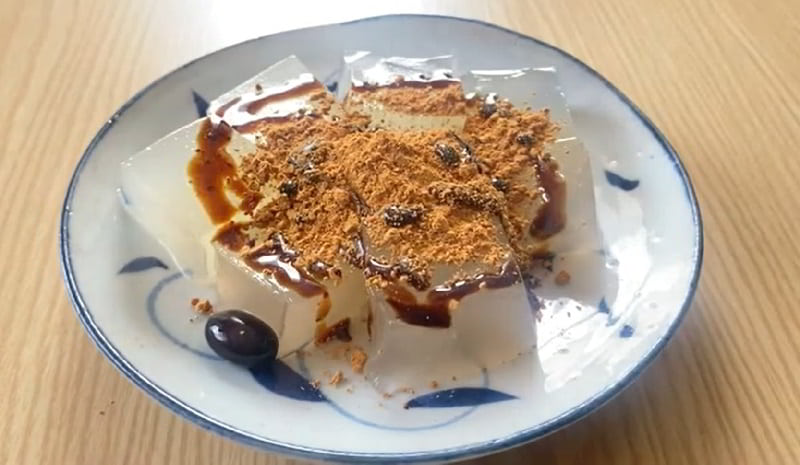
Kuzumochi is a traditional Japanese dessert that combines mochiko, a glutinous rice flour, with kuzuko, a starch derived from the kuzu plant's root. This unique mixture yields a chewy and jelly-like texture. To prepare kuzumochi, mochiko and kuzuko are mixed with water and sugar, then steamed until firm. The resulting cake is then cut into bite-sized pieces and coated with kinako, a roasted soybean powder, for a nutty flavor. Some variations of kuzumochi also incorporate kuromitsu, a dark sugar syrup, to add sweetness. Kuzumochi has a subtly sweet taste and a delicate, melt-in-your-mouth consistency, making it a popular choice for a light and refreshing dessert, especially during the hot summer months.
Kusa Mochi

Kusa mochi, a traditional Japanese dessert, is known for its delightful taste and eye-catching appearance. This unique dish is made up of small, green mochi balls that are created using kusa, or mugwort. To achieve the distinctive flavor and color, glutinous rice is pounded until it becomes sticky and elastic, then mixed with kusa powder. Enjoyed with a sprinkle of kinako, a sweet roasted soybean flour, kusa mochi offers a nutty taste and an enhanced texture. Additionally, a drizzle of kuromitsu, a thick and sweet black sugar syrup, adds a delightful contrast to the mild bitterness of the kusa mochi.
Higashi
-1709214448.jpg)
Higashi, a traditional Japanese dessert, is renowned for its exquisite and intricate designs. This dry sweet is typically crafted from rice flour, sugar, and starch. Higashi presents itself in a variety of shapes and colors, each holding symbolic meanings. It is commonly enjoyed during tea ceremonies and given as gifts on special occasions. The process of creating higashi involves meticulous shaping of the dough through molds or hand techniques. The designs can range from simple geometric patterns to elaborate seasonal motifs such as cherry blossoms or autumn leaves. Afterward, the higashi is carefully dried to achieve a satisfyingly crisp and delicate texture. Despite their ornate appearance, higashi's sweetness is subtle, perfectly balanced with a touch of bitterness. This harmonious combination makes them an ideal accompaniment to Japanese green tea. The delicate flavors and beautiful presentation of higashi embody the Japanese aesthetic of simplicity and meticulousness.
Zunda-Mochi
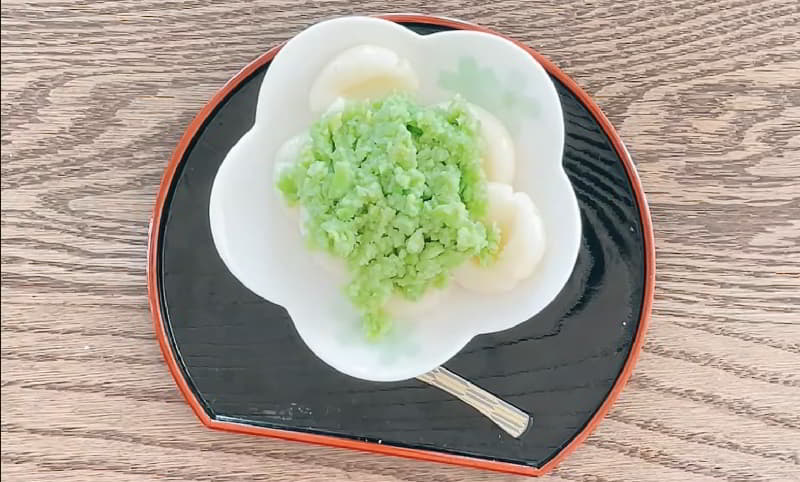
Zunda-mochi is a traditional Japanese dessert that comes from the Tohoku region. It is famous for its vibrant green color and delicious flavor. This sweet treat consists of sticky mochi, a type of rice cake, topped with a generous amount of zunda, a sweetened paste made from edamame beans. The mochi is made by pounding glutinous rice until it becomes a smooth and stretchy dough, which is then shaped into small round or square pieces. To prepare the zunda paste, boiled edamame beans are ground and mixed with sugar, resulting in a creamy and slightly nutty taste. Zunda-mochi is often enjoyed during special celebrations and festivals, especially in the spring when edamame beans are in season. The vibrant green color of the zunda paste not only makes it visually appealing but also symbolizes the freshness and vitality of nature. This delightful combination of soft, chewy mochi and sweet, creamy zunda paste creates a perfect balance of textures and flavors. Zunda-mochi is a beloved dessert in Japan, cherished for its unique taste and cultural significance.
Muchi
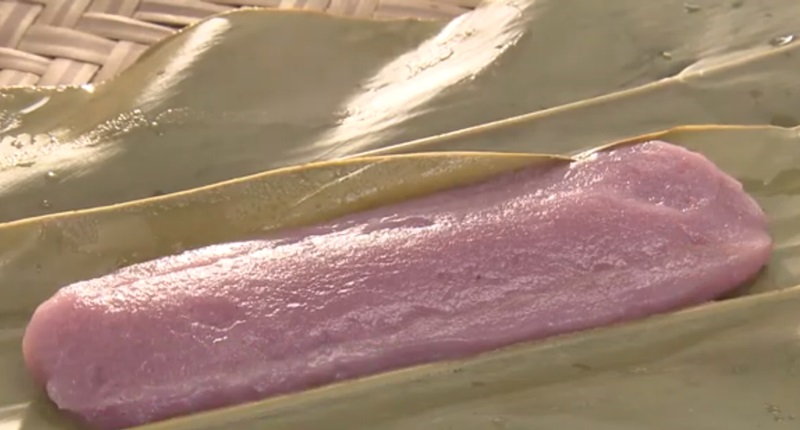
'Mochi', a beloved Japanese delicacy, is renowned for its exceptional texture and cultural significance. It is particularly popular in the Okinawa Prefecture. Made from glutinous rice, which is meticulously pounded to achieve a smooth and elastic consistency, 'mochi' embodies the perfect balance of chewiness and sweetness. Often filled with delectable sweet red bean paste, this treat becomes a true culinary masterpiece with its delicate blend of flavors. In addition to its gastronomic appeal, 'mochi' holds great cultural importance in Japan, symbolizing good fortune and unity. Traditionally enjoyed during festive occasions and ceremonies, the preparation of 'mochi' involves a labor-intensive pounding process that showcases the precision and craftsmanship involved. In modern times, 'mochi' has evolved with a variety of fillings and flavors, solidifying its position as a versatile and cherished part of Japanese culinary heritage. With each delightful and chewy bite, 'mochi' seamlessly bridges the past and present.
Uirō
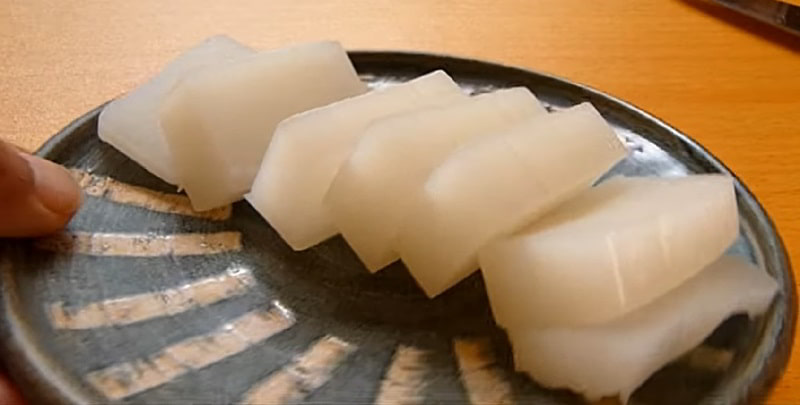
Uirō, a variant of mochi, is a delightful chewy rice cake crafted from glutinous rice flour. What sets uirō apart is its uniquely smooth and soft texture. To create this delectable treat, rice flour is combined with sugar and water, resulting in a gelatinous dough that is steamed to perfection. The dough is then skillfully shaped into bite-sized pieces or molded into charming designs like flowers or animals. For an extra burst of flavor, uirō can be savored as is or coated with kinako, a roasted soybean flour.
Amanattō
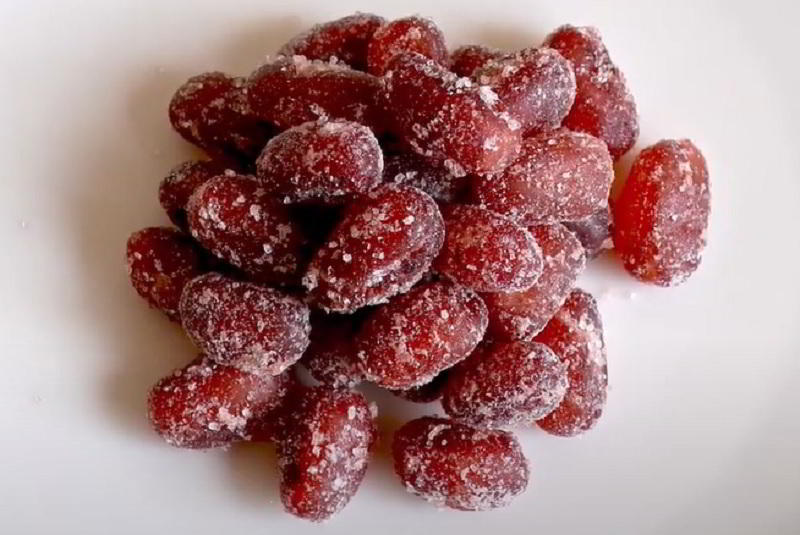
Amanattō, a beloved traditional Japanese sweet, has delighted people for centuries. These small delicacies are crafted from azuki beans, which are first cooked and then coated with a luscious, thick syrup. The beans are simmered until they reach a tender state, infused with a gentle sweetness. The syrup is created by blending sugar and water, then heating it until it transforms into a sticky, delectable texture. Amanattō stands out with its lively hues, often enhanced with natural food coloring sourced from ingredients such as green tea or sakura (cherry blossoms). This not only pleases the palate but also creates an appealing visual experience, turning it into a true feast for both the eyes and taste buds.
Kashiwa Mochi
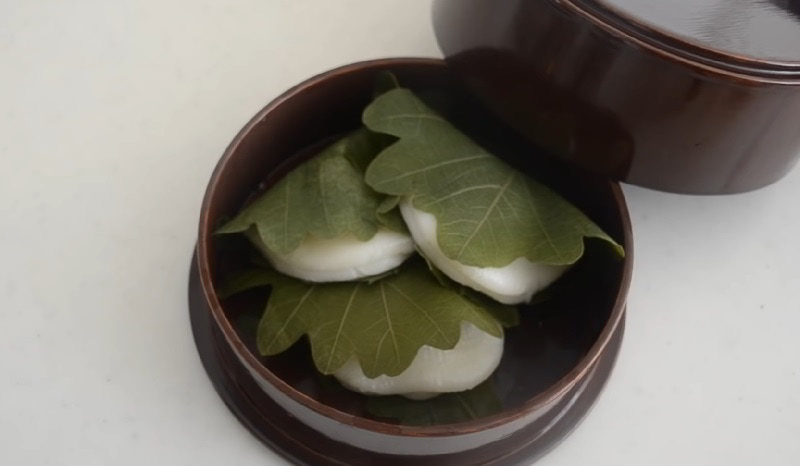
Kashiwa mochi is a traditional Japanese dessert that is commonly enjoyed during Children's Day on May 5th. This delightful treat features a soft and chewy rice cake called mochi, filled with a sweet red bean paste known as anko, and wrapped in an oak leaf called kashiwa. The oak leaf not only adds a beautiful touch to the appearance, but also adds a subtle aroma and flavor to the mochi. The mochi's texture is soft and chewy, while the anko filling provides a smooth and sweet contrast. The combination of different textures and flavors creates a truly delightful experience for the taste buds.
Jintan

Jintan, also known as Japanese medicine dish, is a centuries-old traditional dessert from Japan. This unique sweet treat is created using a blend of medicinal herbs and ingredients that are believed to offer various health advantages. Typically, Jintan's base consists of a mixture of honey, sugar, and medicinal herbs like ginseng, licorice, and dried tangerine peel, carefully chosen for their healing properties. To add a delightful crunch and enhance the flavor, dried fruits, nuts, and seeds are often used as toppings. Jintan is served in small portions, as it is believed that consuming it in moderation maximizes its effectiveness. Its distinct taste is a delightful combination of sweetness, slight bitterness, and herbal undertones. Beyond its unique flavor, Jintan is cherished for its potential health benefits.
Karukan

Karukan is a delightful Japanese treat with its roots in the Kagoshima prefecture. This sweet and chewy dish is crafted using karukan rice flour powder, sugar, and grated Japanese yam. Once the ingredients are blended and mixed with water, the mixture is kneaded and steamed. The end result is a tender, elastic, and white sponge-like texture. What makes this dish truly special is its unique combination of softness and slight firmness. It is commonly shaped into small rectangular pieces, adding to its appeal.
Hishi Mochi
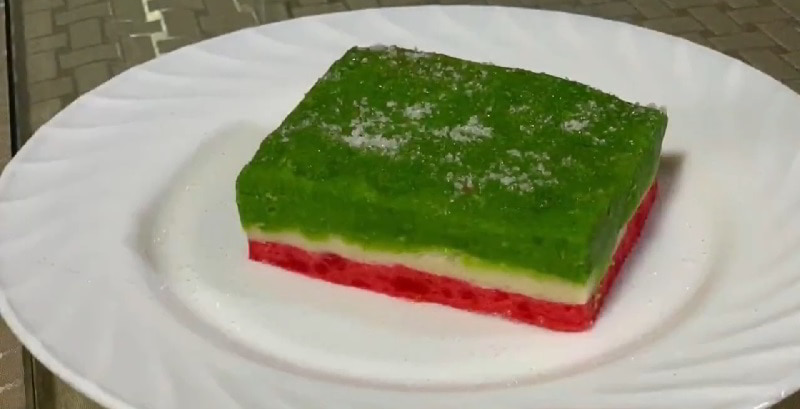
Hishi mochi is a delightful rice cake made from sticky glutinous rice, also known as mochigome. Its name comes from its unique diamond shape, created by layering different colors. These layers are crafted from a variety of ingredients, including red bean paste, green tea paste, and occasionally fruit or nuts. Each layer is carefully stacked, resulting in a visually captivating treat. Hishi mochi is often savored during special occasions like New Year's and Hinamatsuri (Girls' Day), as it is believed to bring good fortune and abundance. The texture of Hishi mochi is wonderfully soft and chewy, owing to the use of glutinous rice in its preparation.
Hanabiramochi
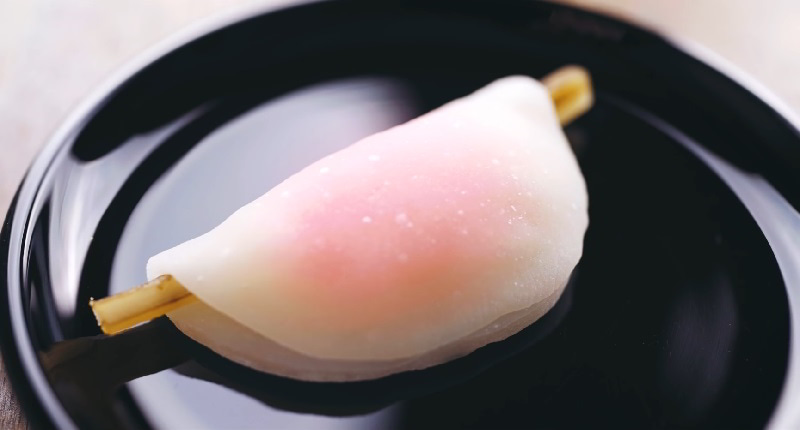
Hanabiramochi is a traditional Japanese confectionery that is not only visually appealing but also deliciously satisfying. This delightful dish consists of a thin layer of soft, chewy mochi (glutinous rice cake) wrapped around a sweet bean paste filling. The name "hanabiramochi" translates to "flower petal mochi," which is a perfect description of its delicate and elegant presentation. The mochi is carefully handcrafted, ensuring a smooth and elastic texture that effortlessly encases the flavorful filling. The sweet bean paste, known as anko, is typically made from azuki beans and is subtly sweet with a hint of earthiness. The dish is often enjoyed during special occasions and festivals in Japan, such as Hinamatsuri (Girls' Day) and New Year's celebrations. Its vibrant colors and intricate patterns make it a feast for the eyes, adding to the overall experience.
Namagashi

Namagashi is a traditional Japanese confectionery that is highly regarded for its delicate beauty and exquisite taste. It is often served during tea ceremonies and special occasions, such as weddings and seasonal celebrations. Namagashi, which translates to "fresh sweets," are meticulously crafted by skilled artisans who have mastered the art of creating edible works of art. These confections are made using natural and seasonal ingredients, such as sweet bean paste, rice flour, sugar, and fruits. Namagashi dishes come in various shapes and sizes, each representing a specific theme or season. They are typically adorned with intricate designs and vibrant colors, showcasing the artistry and attention to detail of the makers. Namagashi is not only visually appealing but also offers a delightful taste experience. The combination of the smooth, velvety texture of the sweet bean paste and the subtle sweetness of the outer layer creates a harmonious balance that melts in your mouth.
Gyūhi
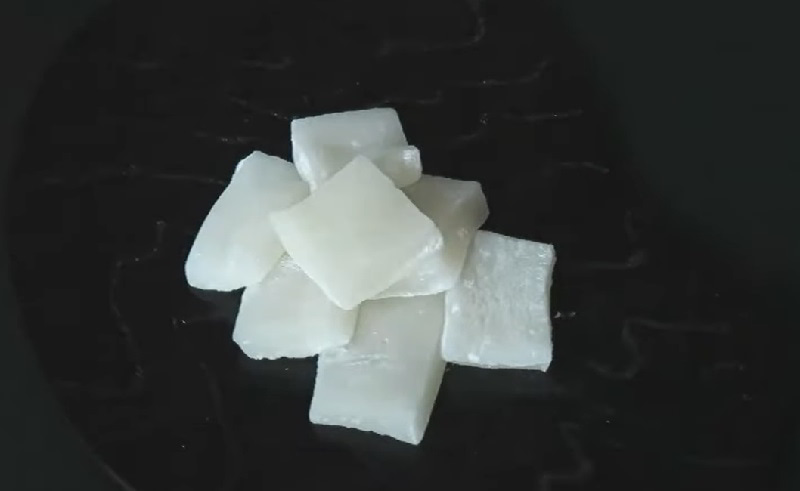
Gyūhi is a traditional Japanese confectionery that is beloved for its soft and chewy texture. It is made from glutinous rice flour, sugar, and water, which are mixed together and then steamed to create a smooth and elastic dough. The dough is then kneaded and shaped into various forms, such as small balls or flat discs. One of the unique aspects of Gyūhi Dish is its versatility. It can be eaten on its own as a sweet treat, or used as a wrapping for other ingredients like red bean paste or fresh fruit.
Ramune Candy
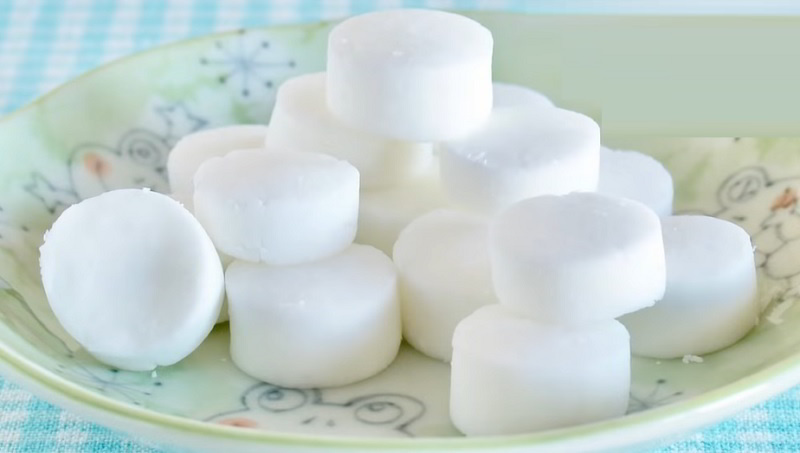
Ramune candy is a popular Japanese confectionery dish that is beloved for its unique and refreshing taste. Named after the famous Japanese carbonated drink, Ramune candy is made to mimic its flavors. The candy is often shaped like small tablets or tablets with a hole in the center, resembling the traditional Ramune bottle. The candy has a sweet and tangy taste that closely resembles the distinct flavor of Ramune soda. It has a fizzy sensation when chewed, which adds to its appeal. The candy is made using a combination of sugar, citric acid, and various fruit flavors, giving it a vibrant and refreshing taste.
Akumaki

Akumaki is a classic Japanese wagashi, also known as a traditional sweet, that is made in Kagoshima, Miyazaki, and Kumamoto Prefecture specifically for the Boys' Festival on May 5th. The preparation involves the soaking of glutinous rice, which is then wrapped in bamboo leaves and left overnight in lye. Its unique flavor, which has a slight bitterness, is often enhanced by enjoying it with a combination of blended sugar and toasted soybean flour (kinako), sometimes accompanied by a hint of salt or honey. This distinct taste makes it an acquired preference among other confections.
Suama
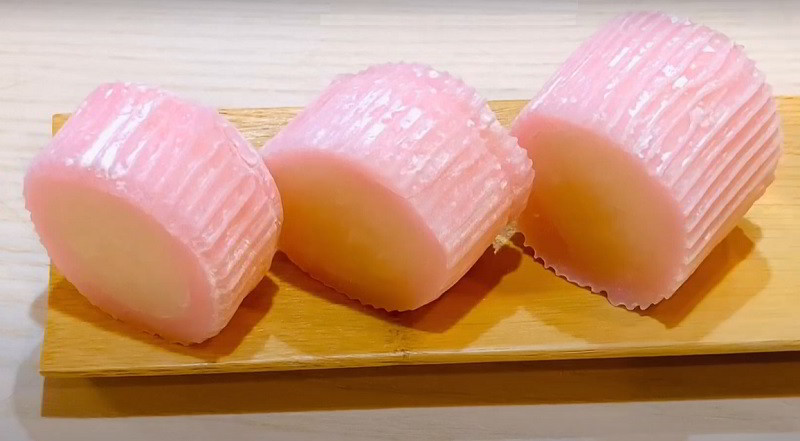
Suama, a traditional Japanese confectionery, is made by combining non-glutinous rice flour, hot water, and sugar. Its name comes from the kanji characters for "celebration" (su) and "sweet" (ama). To achieve its vibrant red color, red food dye is added, symbolizing celebration in Japanese culture. The mixture is kneaded and shaped using a sushi rolling mat (sudare), resulting in a textured, slightly bumpy surface on the final product.
Yubeshi
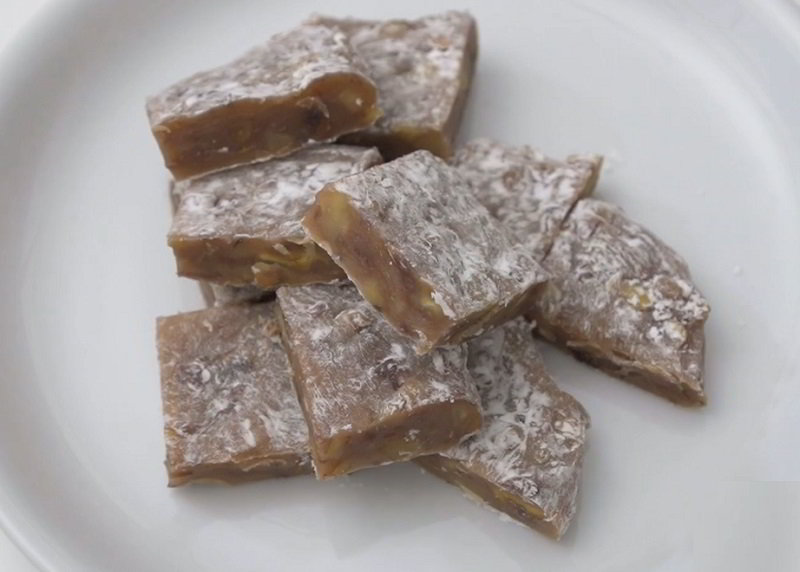
Yubeshi, a traditional Japanese confection, comes in various flavors and shapes, including walnut or the popular yuzu citrus. It can be round or square, but all variations have a base of sticky rice or rice flour, sugar, and soy sauce. The production process is intricate and time-consuming. To start, a circle is cut from the top of a yuzu fruit, which is set aside. Then, the fruit is carefully removed, and the white pith is scraped away, leaving only the zest. The hollowed fruit is then filled with a mixture that can range from plain mochiko flour to a blend of mochiko, shōyu, and spices. The reserved top is placed back as a cap, and the whole fruit is steamed multiple times until it develops a shiny, brown appearance and the mochi filling fully sets. Over time, the yubeshi becomes firmer in texture. Both the rind and filling of yubeshi are edible. It can be served in various ways, such as thinly sliced on top of rice dishes or salads or softened in warm soup dishes.


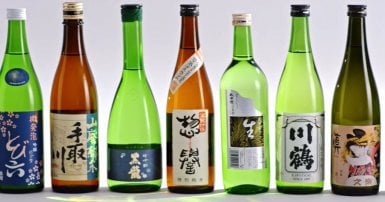
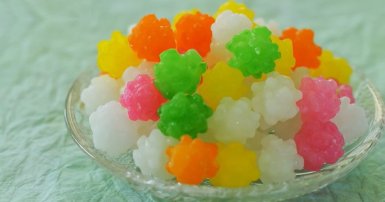
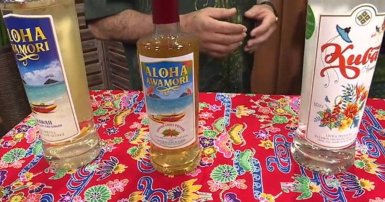
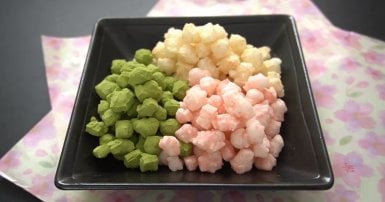
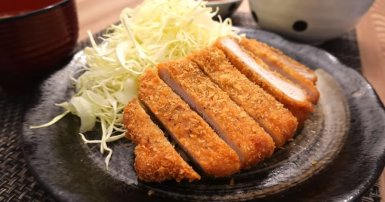
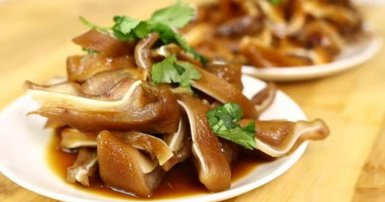
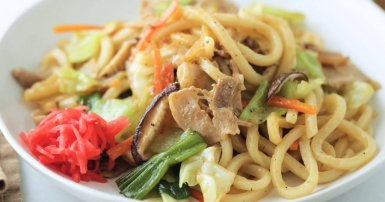
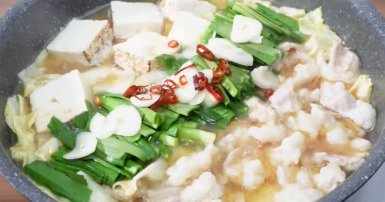

-1709813013.jpg)


